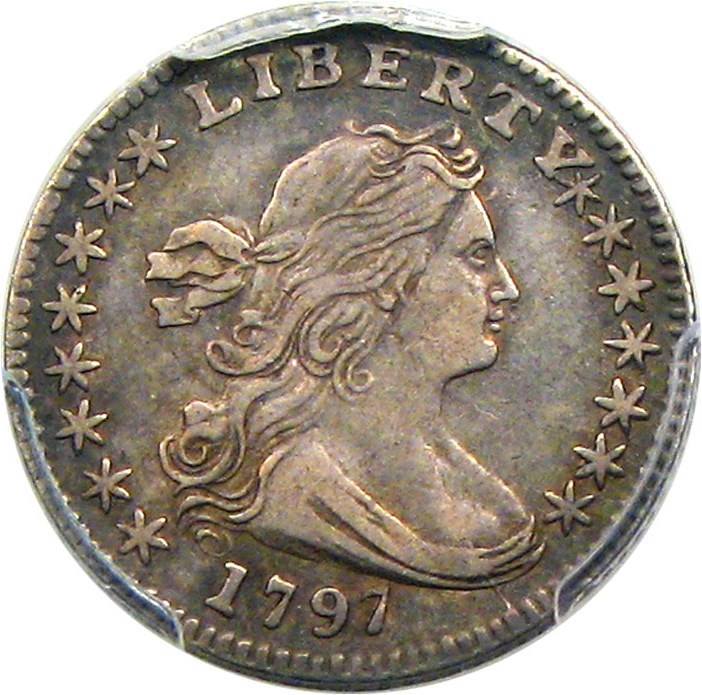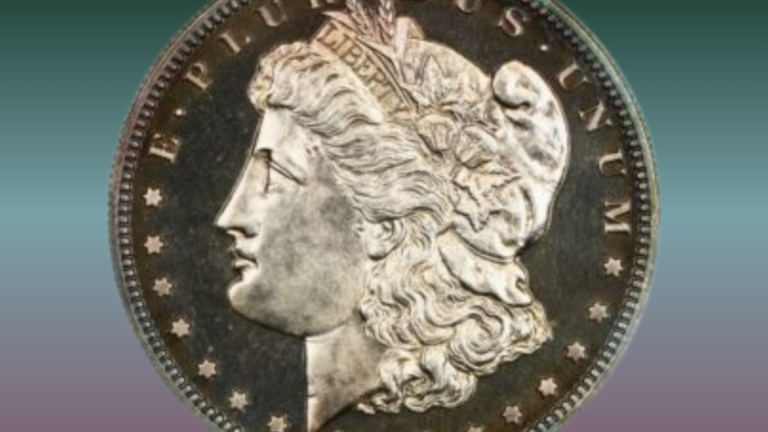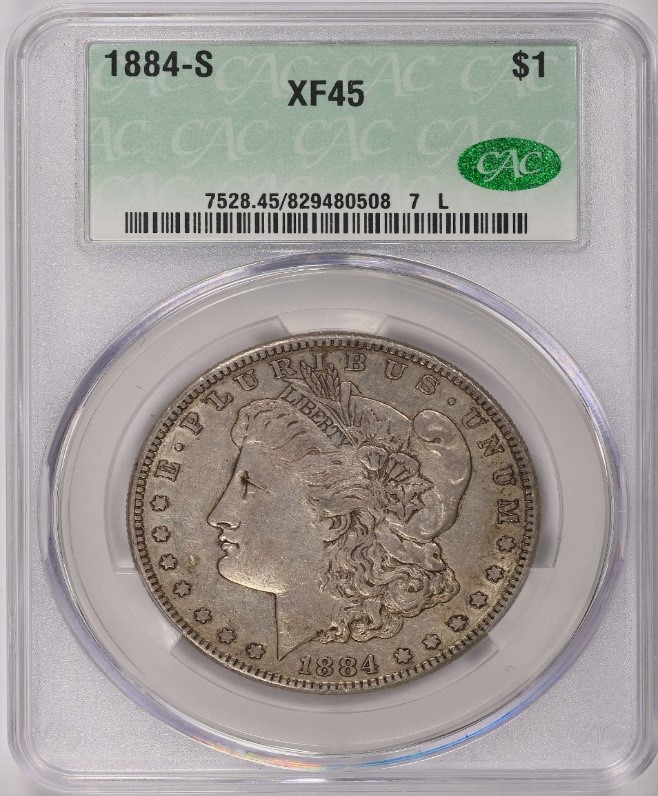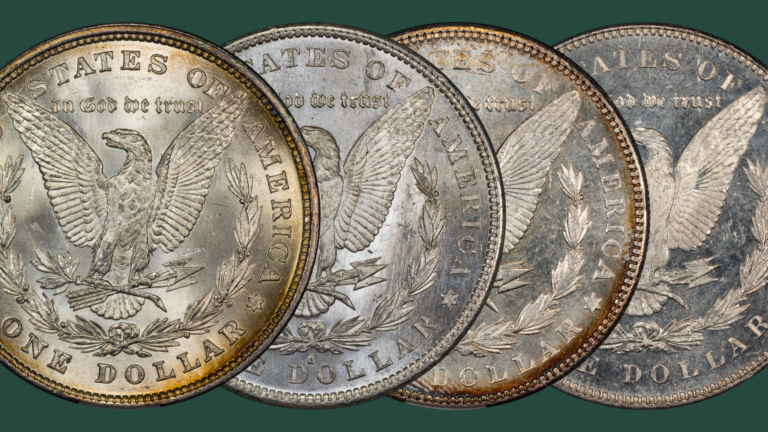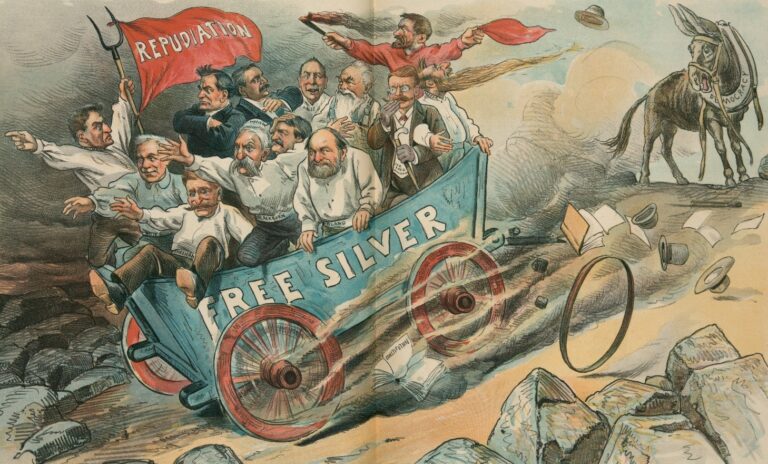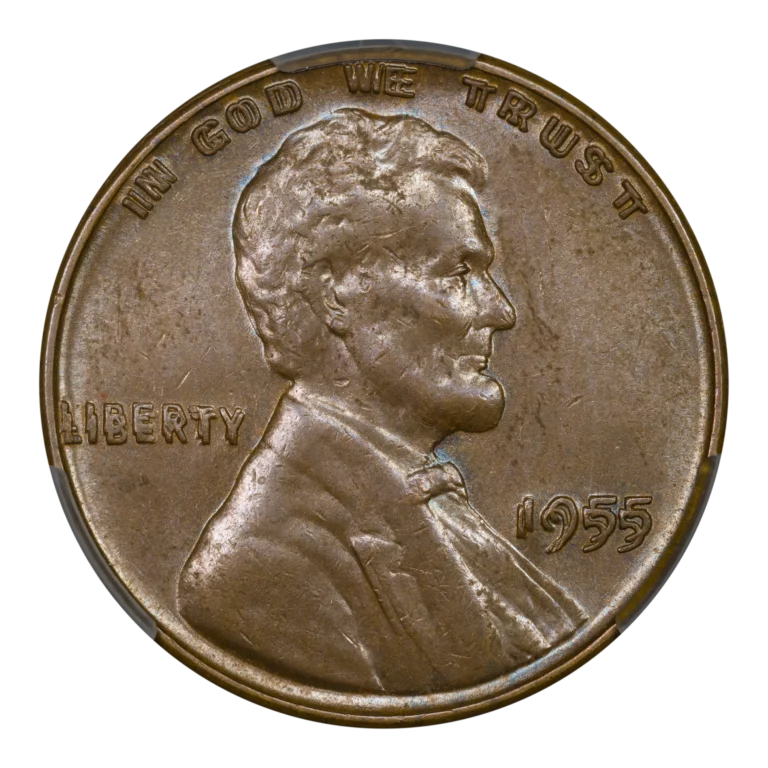by Greg Reynolds

As already mentioned, Flowing Hair half dimes date from 1794 to 1795, Draped Bust – Small Eagle half dimes were minted in 1796 and 1797, and Draped Bust – Heraldic Eagle half dimes date from 1800 to 1805. The only extreme rarity is the 1802. The set is otherwise viable without spending a large amount of money in terms of the market values for ‘early’ (pre-1840) U.S. coins in general. Heraldic Eagle half dimes are not ideal for beginners. Capped Bust half dimes and Liberty Seated half dimes are less expensive and are easy to obtain.
Among Draped Bust, Heraldic Eagle half dimes, only the 1800 is not rare. A central issue is whether the 1803 ‘Large 8’ is so different from the 1803 ‘Small 8’ that these should be categorized as two dates of the same year. I maintain that the ‘Small 8’ is just a minor die variety. The ‘Small 8’ is not that small and the ‘Large 8’ is not oddly large.
On 1803 half dimes, the dentils and a portion of the rim near the numerals tend to be weakly struck and the numeral 8 was often poorly defined when struck. Further, the numeral ‘8’ tended to wear rapidly from minimal circulation. The numerals on U.S. coins from 1800 to 1805, especially on half dimes, are often crude and childish anyway. It would not make sense to regard minor anomalies or slight differences in size as indicators of multiple distinct dates of a given year.
This distinction between the 1803 ‘Small 8’ and the ‘Large 8’ has been and will continue to be analyzed by die variety specialists, sometimes with the aid of a microscope. It should not be a concern of collectors who are building sets ‘by date.’
The immediate point is that either an 1803 ‘Large 8’ or an 1803 ‘Small 8’ would satisfy the requirement for an 1803 in a set ‘by date’; there is no need to acquire representatives of both. As the 1803 ‘Small 8’ is the face of an especially rare die variety, it is typically sought by collectors who are assembling sets by die pairing or sets of all die varieties of bust half dimes. For collectors building sets ‘by date,’ just an 1803 ‘Large 8’ is likely to be pursued.
Requirements for a Complete Set by Date
A complete set ‘by date’ of this type includes 1800, 1801, 1802, 1803 and 1805 half dimes. The 1800 ‘LIBEKTY’ variety is more apparent than the 1796 ‘LIKERTY’ variety. There is no doubt that the 1800 ‘normal letters’ and the 1800 LIBEKTY were struck with different obverse dies and that the difference is noticeable without magnification. There was something wrong with the the ‘R’ punch such that it slightly resembles the letter ‘K.’
In my view, only one 1800 half dime is required for a set ‘by date,’ though I understand why some collectors think otherwise. The 1800 ‘LIBEKTY’ tends to be worth from 5% to 25% more than an equivalent 1800 with ‘normal letters.’ Although I believe that one or the other is sufficient, I mention public sale results for both to provide collectors with some idea as to prices recently paid for these. Also, a couple of 1800 ‘LIBEKTY’ half dimes are mentioned in the discussion of collecting circulated half dimes ‘by design type.’
In February 2018, Heritage auctioned a CAC approved VF-25 grade 1800 ‘normal letters’ half dime for $3360. In April 2018, Heritage auctioned a CAC approved AU-50 grade 1800 ‘normal letters’ half dime for $5760.
On June 9, 2019, GreatCollections sold a CAC approved AU-53 grade 1800 ‘normal letters’ half dime for $7093.12. On January 6, 2019, GreatCollections sold a CAC approved AU-58 grade 1800 ‘LIBEKTY’ half dime for $8447.62.
The Coveted 1801 Half Dime

I estimate that around 120 1801 half dimes survive. The combined total of 1801 half dimes that have received numerical grades from PCGS and NGC is one hundred and four, seventy-three by PCGS and thirty-one by NGC. I suggest that this total amounts to around sixty-five different coins, nine of which have been CAC approved. For various reasons, individual coins have been resubmitted since PCGS was founded in 1986 and NGC in 1987.
It is probably true that not all of the sixty-five PCGS or NGC graded 1801 half dimes have been submitted to CAC, which was founded in October 2007. There is a fair chance that a few more will be CAC approved in the future.
NGC reports having placed thirty-four 1801 half dimes in ‘details’ holders, coins that failed to receive numerical grades because of serious problems. I do not know how many are in ‘PCGS Genuine’ or PCGS ‘details’ holders. Coin doctors often buy coins in ‘details’ holders, crack them out, modify them and submit them to PCGS or NGC with the objective of receiving numerical grades. Besides, the dividing line between coins that are gradable and those that are ungradable is not perfectly clear, especially in regard to pre-1840 coins.
As already stated, Heraldic Eagle half dimes are very difficult to grade. A coin that was certified as grading VF-35 may be certified as AU-50 years later.
On July 15, 2020, Heritage auctioned an 1801 in an NGC holder, with a label that indicates that this coin is ungradable, ‘Fair Details – Damaged,’ for $360. This may have been a very good deal.
On March 19, 2020, Stack’s-Bowers auctioned a PCGS graded VG-08 1801, without a CAC sticker, for $1560. About a year earlier, on March 28, 2019, Kagin’s auctioned an NGC graded VG-10 1801, also without a CAC sticker, for $2160.
In September 2019, Heritage auctioned a PCGS graded AU-58 1801, without a CAC sticker, for $10,800. In June 2018, Stack’s-Bowers auctioned a CAC approved, PCGS graded AU-58 1801 for $18,600.

The 1802 Draped Bust Half Dime

The 1802 is a major rarity, which has been very famous for more than 150 years. Researchers believe that they have identified more than thirty different coins. Generally, it is estimated that between thirty-five and fifty 1802 half dimes survive. As I said years ago in a now defunct Internet publication, I maintain that the true number is lower than thirty-five. The appearances of coins change over time, either by chance or due to intentional activity. In some cases, a reason why coins are modified is to disguise or obliterate their pedigree.
When dealers buy coins in auctions without specific collector-clients in mind, they often do not wish for prospective buyers to know how much was paid for the specific coin in any auction. It is not unusual for coins to be modified such that they appear different. Another motive for modification is to seek upgrades. For a major rarity, an XF-45 grade assignment may be worth much more than a VF-35 grade assignment for the same coin. If a coin is currently certified as XF-45 and was previously certified as VF-35, a seller may not wish for prospective buyers to know that it was assigned a grade in the past that is lower than its current grade. The appearance of coins also changes due to natural toning over the years, and 1802 half dimes were minted about 218 years ago.
Could it be true that several of the 1802 half dimes that appear to be different coins are the same coins, which appear to be different in later photographs? Many surviving pre-1807 U.S. coins have been cleaned with harsh chemicals in the past, have developed dark or blotchy toning, have been markedly dipped in acidic solutions, or have been subject to other treatments. If a coin that was once very dark is substantially lightened, then it might appear to be a different coin. A light coin that naturally retones may appear different as well. The immediate point here is that 1802 half dimes are rarer than some researchers believe them to be.
Researchers who rely on published images, and have not scrutinized the respective coins in actuality, should be careful about concluding that two sets of images are really of two different coins. Only two 1802 half dimes have been CAC approved as of December 7, 2020, and most surviving 1802 half dimes have problems.
The quality and rarity of surviving 1802 half dimes are difficult to analyze. A few 1802 half dimes in PCGS or NGC ‘details’ holders, thus failing to receive numerical grades, have sold over the last ten years for amounts between $15,000 and $50,000.
In the September 2019 catalogue by Heritage for an auction at a Long Beach Expo, it is noted by someone at Heritage that “Certification is a must” for 1802 half dimes “because many 19th century altered dates exist.” A “PCGS Genuine / Repaired – G Detail” 1802 half dime then realized $38,400. My hunch is that the injuries suffered by this coin are too severe for me to find it to be tolerable.
In January 2017, Heritage auctioned the Eliasberg 1802 half dime. I examined it then and earlier during the Eliasberg ’96 event conducted by Bowers & Merena (New Hampshire). On May 22, 1996, this 1802 realized $42,900, reasonable in retrospect. During the 1980s and 1990s, there was a heavy emphasis in the coin community upon gem quality silver coins. Condition rarities often attracted more attention than absolute rarities.
An 1802 half dime is an excellent example of an absolute rarity that is very much distinct from the concept of a condition rarity. There are no gem or choice 1802 half dimes. Indeed, no uncirculated 1802 half dimes survive.
The Eliasberg coin is exceptional for an 1802 half dime and would be an appealing coin even it was dated 1800 or 1803. The grays, brown-russet and green tones are attractive. It was PCGS graded AU-53 and CAC approved. Although the Eliasberg 1802 sold for $329,000 in January 2017, it has been claimed on the Heritage web site that the owner turned down an offer of “$395,000 on October 10, 2018.”

Show off Your Collection in the CAC Registry!
Have CAC coins of your own? If so, check out the CAC Registry–the free online platform to track your coin inventory, showcase your coins by building public sets, and compete with like-minded collectors!
The Rarity of an 1803 Half Dime
While 1803 half dimes appear more often than 1802 half dimes, 1803 half dimes are rare, perhaps very rare. On February 26, 2020, Heritage sold an ungradable 1803 half dime that was said to have been “repaired” and is in a PCGS “Genuine” holder with “F[ine] Detail” noted on the label. This coin, which may be tolerable, brought $870, not a large sum to lose in a quest to assemble a set of Flowing Hair and bust half dimes. On September 15, 2019, the firm of David Lawrence sold a PCGS graded VG-10 1803 for $1900. I am not certain that I would find this coin to be gradable.
Market data suggests that I am not the only one who finds that the “Small 8” is not significantly different from the “Large 8” 1803. Although the ‘Small 8’ variety is almost as rare as the 1802, these are not especially expensive. If collectors and relevant researchers really thought that the 1803 ‘Small 8’ was a distinct date or a major variety needed for a set, 1803 ‘Small 8’ half dimes would be worth far more than they are worth.
For example, in April 2018, David Lawrence sold a CAC approved, PCGS graded VF-35 “Small 8” 1803 for $9150. If many collectors demanded both ‘Large 8’ and ‘Small 8’ 1803 half dimes, then a VF-35 grade ‘Small 8’ 1803 would sell for more $40,000 rather than $9150! In February 2014, Stack’s-Bowers auctioned a PCGS graded VG-08 1802 for $117,500.
Despite the fact that the 1803 ‘Small 8’ is not especially expensive, given its rarity, 1803 ‘Large 8’ half dimes are less costly and are much better values. On June 5, 2020, Heritage auctioned a PCGS graded VF-35 1803 ‘Large 8’ half dime, without a CAC sticker, for $3360. In August 2019, Heritage auctioned a CAC approved, PCGS graded AU-58 1803 ‘Large 8’ half dime for $9900.
The Remainder of 1805 Half Dimes
Unfortunately, there were no half dimes dated 1804. The 1805 is almost extremely rare. I tentatively estimate that around one hundred and ten exist, perhaps half of these are gradable in my opinion. As of December 7, 2020, CAC has approved fifteen 1805 half dimes.
On August 26, 2020, Heritage sold an 1805 in a PCGS “Genuine” holder, “Plugged – F Detail,” for $990. This coin may have been tooled and extensively reworked in addition to having been plugged. Nevertheless, images suggest that this 1805 has a half-decent overall appearance and may possibly fit well enough into a set of gradable, circulated coins.
In April 2018, Heritage sold a CAC approved, PCGS graded Good-06 1805 for $3120. The CPG-CAC retail price estimate for an XF-40 1805 was $15,700, as of December 7, 2020. Collectors seem to pounce upon them when 1805 half dimes are offered by coin dealers.
Conclusion
A set of circulated, Heraldic Eagle half dimes (1800-05) can be completed in a few years with pleasing coins of most dates and an 1802 that is at least half-decent, perhaps fully decent. The difficulty involved in completing a set during a particular time period depends in part upon the 1802 and 1805 half dimes that become available, and upon how concerned the collector is about the quality of the coins selected.
I suggest that collectors work on multiple sets at the same time. It is common for a collector to focus on two or three time periods, denominations and/or metals. For example, it may be enjoyable and relaxing for a collector to devote five to ten years to building sets ‘by date’ of bust half dimes and bust half dollars.
Copyright © 2021 Greg Reynolds
About the Author
Greg is a professional numismatist and researcher, having written more than 775 articles published in ten different publications relating to coins, patterns, and medals. He has won awards for analyses, interpretation of rarity, historical research, and critiques. In 2002 and again in 2023, Reynolds was the sole winner of the Numismatic Literary Guild (NLG) award for “Best All-Around Portfolio”.
Greg has carefully examined thousands of truly rare and conditionally rare classic U.S. coins, including a majority of the most famous rarities. He is also an expert in British coins. He is available for private consultations.
Email: Insightful10@gmail.com
